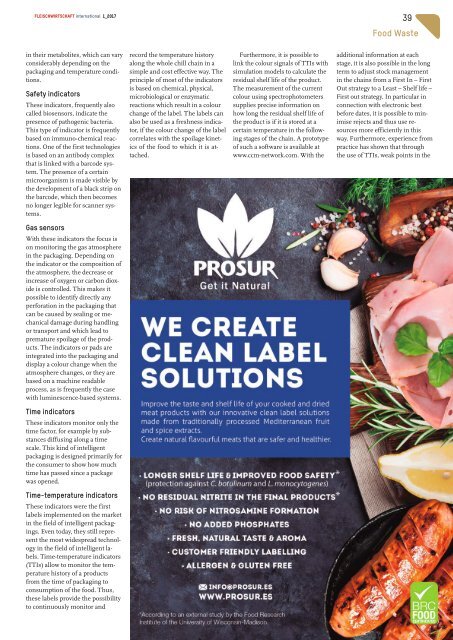FLEISCHWIRTSCHAFT international 1/2017
You also want an ePaper? Increase the reach of your titles
YUMPU automatically turns print PDFs into web optimized ePapers that Google loves.
Fleischwirtschaft <strong>international</strong> 1_<strong>2017</strong><br />
39<br />
Food Waste<br />
in their metabolites, which can vary<br />
considerably depending on the<br />
packaging and temperature conditions.<br />
Safety indicators<br />
These indicators, frequently also<br />
called biosensors, indicatethe<br />
presence of pathogenic bacteria.<br />
This typeofindicator is frequently<br />
based on immuno-chemical reactions.<br />
One of the first technologies<br />
is based on an antibodycomplex<br />
that is linked with abarcode system.<br />
Thepresence of acertain<br />
microorganism is made visible by<br />
the development of ablack strip on<br />
the barcode, which then becomes<br />
no longer legible for scanner systems.<br />
record the temperature history<br />
along the whole chill chain in a<br />
simple and cost effective way.The<br />
principle of most of the indicators<br />
is based on chemical, physical,<br />
microbiological or enzymatic<br />
reactions which result in acolour<br />
change of the label. Thelabels can<br />
also be used as afreshness indicator,<br />
if the colour change of the label<br />
correlates with the spoilage kinetics<br />
of the food to which it is attached.<br />
Furthermore, it is possible to<br />
link the colour signals of TTIs with<br />
simulation models to calculatethe<br />
residual shelf life of the product.<br />
Themeasurement of the current<br />
colour using spectrophotometers<br />
supplies precise information on<br />
how long the residual shelf life of<br />
the productisifitisstored at a<br />
certain temperature in the following<br />
stages of the chain. Aprototype<br />
of such asoftware is available at<br />
www.ccm-network.com. With the<br />
additional information at each<br />
stage, it is also possible in the long<br />
term to adjust stockmanagement<br />
in the chains from aFirst In –First<br />
Out strategy to aLeast–Shelf life –<br />
First out strategy.Inparticular in<br />
connection with electronic best<br />
before dates, it is possible to minimise<br />
rejects and thus use resources<br />
more efficiently in this<br />
way.Furthermore, experience from<br />
practice has shown that through<br />
the use of TTIs, weak points in the<br />
Gas sensors<br />
With these indicators the focus is<br />
on monitoring the gas atmosphere<br />
in the packaging. Depending on<br />
the indicator or the composition of<br />
the atmosphere, the decrease or<br />
increase of oxygen or carbon dioxide<br />
is controlled. This makes it<br />
possible to identify directly any<br />
perforation in the packaging that<br />
can be caused by sealing or mechanical<br />
damage during handling<br />
or transport and which lead to<br />
premature spoilage of the products.<br />
Theindicators or pads are<br />
integrated intothe packaging and<br />
display acolour change when the<br />
atmosphere changes, or theyare<br />
based on amachine readable<br />
process, as is frequently the case<br />
with luminescence-based systems.<br />
Time indicators<br />
These indicators monitor only the<br />
time factor, forexample by substances<br />
diffusing along atime<br />
scale. This kind of intelligent<br />
packaging is designed primarily for<br />
the consumer to showhow much<br />
time has passed since apackage<br />
was opened.<br />
Time-temperature indicators<br />
These indicators were the first<br />
labels implemented on the market<br />
in the field of intelligent packagings.<br />
Even today,theystill represent<br />
the most widespread technology<br />
in the field of intelligent labels.<br />
Time-temperature indicators<br />
(TTIs) allow to monitor the temperature<br />
history of aproducts<br />
from the time of packaging to<br />
consumption of the food.Thus,<br />
these labels provide the possibility<br />
to continuously monitor and

















